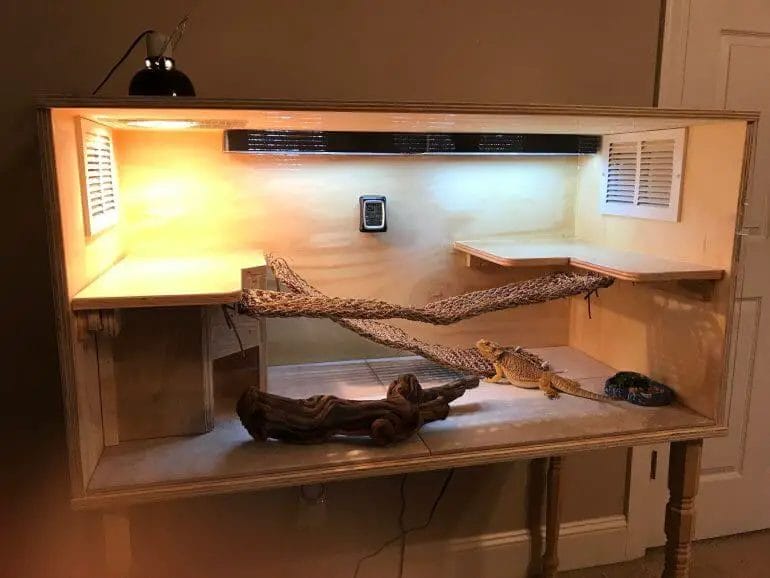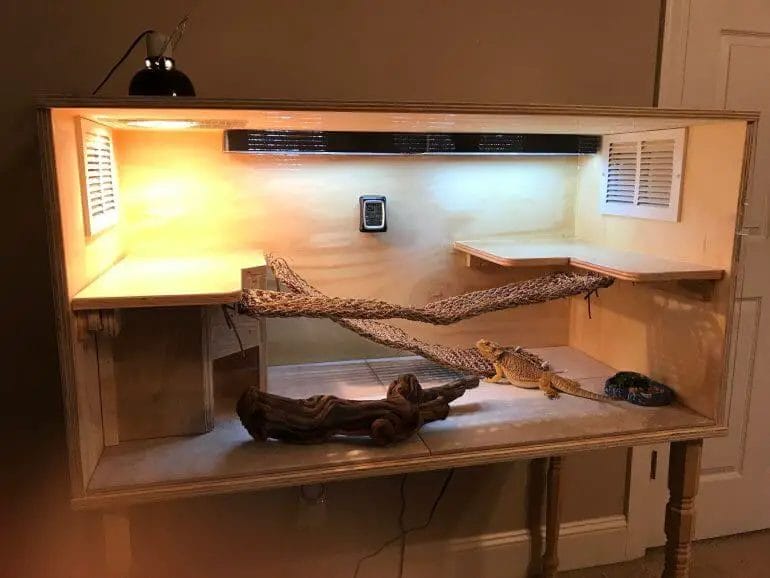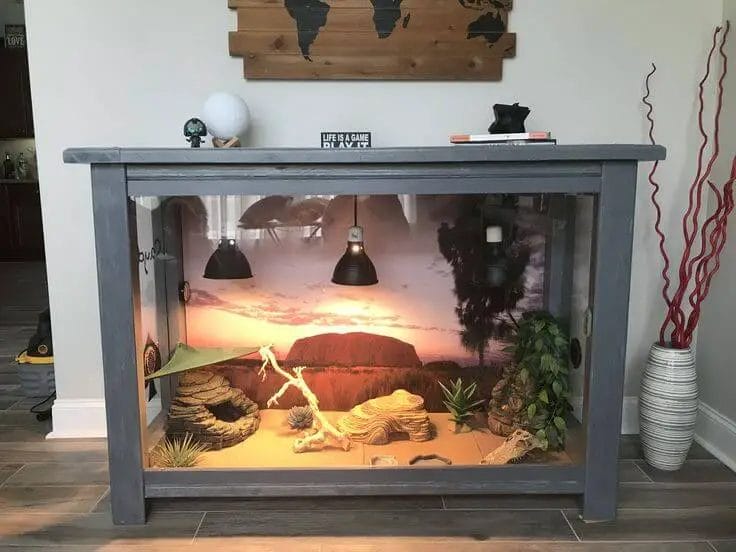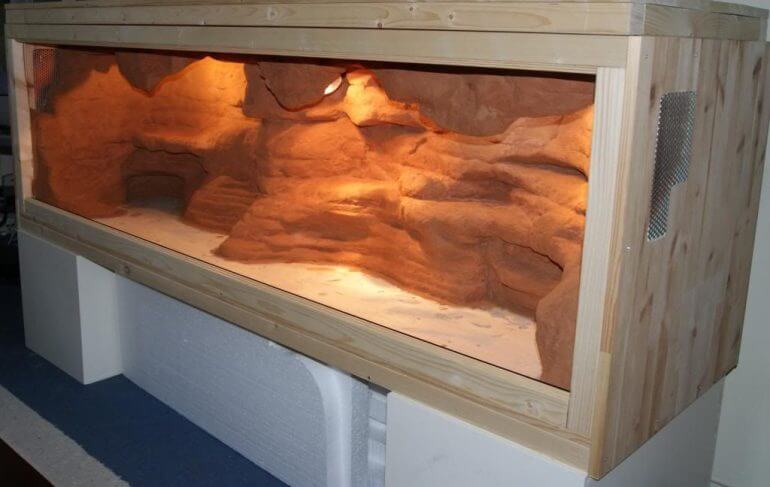Looking to create a custom bearded dragon cage out of wood? You’ve come to the right place! Building a wooden enclosure for your bearded dragon is a great way to provide them with a safe and comfortable living space. In this guide, we’ll walk you through the steps of constructing a bearded dragon cage using wood, ensuring you have all the information you need to create the perfect habitat for your scaly friend.
First, gather all the necessary materials and tools, including wood panels, screws, hinges, and a screen for ventilation. Measure and cut the wood panels according to your desired dimensions for the cage. Next, assemble the panels using screws to create the frame of the enclosure.

Ensure the cage has proper ventilation by attaching a screen to the top or sides. This will allow for fresh air circulation and prevent any overheating. Additionally, don’t forget to add a secure door that can be easily opened for feeding and cleaning purposes.
Now it’s time to add the essential components inside the cage. Include a heat source, such as a heat lamp or ceramic heat emitter, to maintain the proper temperature gradient for your bearded dragon’s needs. Provide a basking spot, a UVB light source, and various hiding spots using rocks, branches, or specially designed reptile accessories.
Finally, line the flooring of the cage with a suitable substrate, such as reptile carpet or non-toxic sand

Choosing the Right Type of Wood for Your Bearded Dragon Cage
When it comes to creating the perfect habitat for your bearded dragon, choosing the right type of wood for their cage is essential. The type of wood you use can have a significant impact on their overall health and well-being. In this section, we will discuss the different types of wood that are safe for your bearded dragon and provide tips on how to select the best option for their enclosure.
1. Safe Wood Options
Not all types of wood are suitable for bearded dragon cages. Some woods can be toxic and harmful if ingested or if the dragon comes into contact with them. Therefore, it is crucial to choose safe wood options that are non-toxic and do not pose any health risks. Here are some recommended types of wood:
- Oak: Oak wood is a popular choice due to its durability and resistance to rot. It is safe for bearded dragons and provides a natural and aesthetic appeal to their enclosure.
- Maple: Maple wood is another safe option that is commonly used in reptile enclosures. It is non-toxic and easy to work with, making it an ideal choice for creating custom structures.
- Birch: Birch wood is known for its light color and smooth texture. It is a safe choice for bearded dragons and can be used for branches, perches, and other decorative elements in their cage.
- Grapevine: Grapevine wood is an excellent choice for providing climbing opportunities for your bearded dragon. It is safe and can add an interesting aesthetic to their enclosure.
2. Avoid Toxic Wood
While some woods are safe for bearded dragons, there are certain types of wood that should be avoided due to their toxicity. These types of wood can release harmful chemicals or contain substances that are toxic to reptiles. Here are a few examples of woods to avoid:
- Cedar: Cedar wood contains aromatic oils that can be toxic to reptiles. It should never be used in bearded dragon cages as it can cause respiratory issues and skin irritations.
- Pine: Pine wood also contains oils that can be harmful to reptiles. It can lead to respiratory problems and negatively affect the health of your bearded dragon.
- Juniper: Juniper wood is known for its strong aroma, which can be detrimental to the respiratory system of bearded dragons. It is best to avoid using this type of wood in their enclosure.
3. Preparing the Wood
Before using any type of wood in your bearded dragon’s cage, it is crucial to properly prepare it to ensure it is safe for your pet. Here are some steps to follow when preparing wood for your dragon’s enclosure:
- Choose untreated wood: Make sure the wood you select is untreated and free from any chemicals or coatings that may be harmful to your bearded dragon.
- Remove bark: Remove any loose bark from the wood, as it can pose a potential choking hazard or contain harmful substances.
- Sand the wood: Sand the wood to remove any rough edges or splinters that could harm your bearded dragon. Smooth surfaces are essential to prevent injuries.
- Disinfect and dry: Disinfect the wood by using a reptile-safe disinfectant and allow it to dry thoroughly before placing it in the enclosure.
4. Monitoring and Maintenance
After setting up your bearded dragon’s cage with the chosen wood, it is essential to regularly monitor and maintain the wood to ensure its safety. Check for any signs of damage, mold, or deterioration and replace or repair as needed. Additionally, regular cleaning and disinfecting of the wood structures will help maintain a clean and healthy environment for your bearded dragon.
Summary
Choosing the right type of wood for your bearded dragon cage is crucial for their overall well-being. Oak, maple, birch, and grapevine are some safe options that can be used to create a natural and stimulating habitat. It is important to avoid toxic woods such as cedar, pine, and juniper, as they can be harmful to your reptile. By properly preparing and maintaining the wood, you can provide a safe and

Essential Tools and Materials for Building a Wooden Bearded Dragon Cage
When it comes to creating a comfortable and safe environment for your bearded dragon, a wooden cage can be an excellent choice. Building a wooden bearded dragon cage allows you to customize the size, design, and features according to your pet’s needs. However, to ensure a successful construction project, you will need some essential tools and materials. In this section, we will discuss the key items you will need for building a wooden bearded dragon cage.
1. Tape Measure and Level
Accurate measurements are crucial when constructing a wooden bearded dragon cage. A tape measure will help you determine the correct dimensions for the cage’s walls, floors, and other components. Additionally, a level will ensure that your cage is built on a flat surface, providing stability and balance.
2. Saw and Drill
A saw is essential for cutting and shaping the wooden pieces that will make up the cage. You can use a hand saw or a power saw, depending on your preference and the complexity of the project. A drill will come in handy when creating holes for ventilation or attaching components together.
3. Screwdriver and Screws
Assembling a wooden bearded dragon cage often involves using screws to secure the pieces together. A screwdriver with various sizes and types of heads will make the assembly process much easier. Make sure to choose screws that are appropriate for wood, such as wood screws.
4. Sandpaper and Wood Sealer
Smooth out any rough edges or surfaces using sandpaper. This will prevent your bearded dragon from getting splinters or scratches. After sanding, applying a wood sealer will protect the wood from moisture and make it easier to clean and maintain.
5. Mesh or Screen Material
Proper ventilation is crucial for your bearded dragon’s health. You will need mesh or screen material to create ventilation areas in the cage. Choose a material that is safe for your pet and has small enough gaps to prevent escape or injury.
6. UVB Lighting Fixture and Heat Lamp
Bearded dragons require UVB lighting to aid in calcium absorption and maintain optimal health. Invest in a quality UVB lighting fixture that can be securely mounted inside the cage. Additionally, a heat lamp is necessary to provide the appropriate temperature gradient for your pet.
7. Substrate and Decorations
Choose a suitable substrate for the cage floor that is easy to clean and helps maintain proper humidity levels. Options such as reptile carpet, paper towels, or slate tiles are commonly used. Consider adding decorations, such as branches, rocks, and hiding spots, to create an enriching and stimulating environment for your bearded dragon.
8. Thermometer and Hygrometer
Monitoring the temperature and humidity inside the cage is essential for your bearded dragon’s well-being. A thermometer will help you keep track of the cage’s temperature, while a hygrometer will measure the humidity levels. Place these instruments in different areas of the cage to ensure accurate readings.
With these essential tools and materials, you will be well-prepared to embark on your wooden bearded dragon cage building project. Remember to prioritize the safety and comfort of your pet throughout the construction process. In the next section, we will discuss the step-by-step process of building a wooden bearded dragon cage.

Ventilation and Heating Options for a Wooden Cage
Proper ventilation and heating are essential for maintaining a healthy and comfortable environment for the inhabitants of a wooden cage, such as small pets like rabbits, guinea pigs, or birds. In this section, we will discuss various ventilation and heating options that can be implemented in a wooden cage to ensure optimal conditions.
Ventilation
Good ventilation is crucial to prevent the build-up of stale air, moisture, and foul odors inside the wooden cage. Insufficient ventilation can lead to respiratory issues and other health problems for the pets. Here are some ventilation options to consider:
Heating
In colder climates or during the winter months, it is important to provide adequate heating inside the wooden cage to keep the pets warm and comfortable. Here are some heating options to consider:
Considerations
When implementing ventilation and heating options in a wooden cage, there are a few important considerations to keep in mind:
In summary, proper ventilation and heating are vital for maintaining a comfortable and healthy environment within a wooden cage. Implementing suitable ventilation options, such as air vents, wire mesh panels, or windows, helps ensure adequate airflow. For heating, options like heat mats, heat lamps, or heated bedding provide warmth during colder temperatures. Always prioritize the safety and well-being of your pets when selecting and installing ventilation and heating systems for their wooden cage.
Maintaining and Cleaning a Wooden Bearded Dragon Cage
Keeping a clean and well-maintained environment is essential for the health and well-being of your bearded dragon. If you have a wooden cage for your pet, there are specific steps you need to take to ensure its longevity and cleanliness. In this section, we will discuss the necessary maintenance and cleaning tasks for a wooden bearded dragon cage.
1. Regular Spot Cleaning
Spot cleaning involves removing any visible waste or debris from the cage on a daily basis. This step helps maintain a hygienic environment for your bearded dragon and prevents the accumulation of bacteria or odors. Use a reptile-safe disinfectant or a mixture of water and mild dish soap to clean the affected area. Gently scrub the spot with a soft brush or cloth and rinse thoroughly. Ensure the area is completely dry before returning your pet to the enclosure.
2. Deep Cleaning
Deep cleaning is a more thorough process that should be done periodically to maintain the overall cleanliness of the wooden cage. It involves removing your bearded dragon and all its belongings from the enclosure before proceeding with the cleaning steps.
2.1. Remove any loose substrate, rocks, or decorations from the cage. Wash them with warm water and mild dish soap. Rinse thoroughly and allow them to air dry.
2.2. Empty the remaining bedding or substrate from the enclosure. Dispose of any soiled or contaminated material properly.
2.3. Clean the interior of the cage using a reptile-safe disinfectant spray or wipes. Pay special attention to the corners, crevices, and any areas where waste tends to accumulate. Wipe down all surfaces, including the walls, floor, and ceiling. Rinse with water and allow the cage to air dry completely.
2.4. Inspect the cage for any signs of damage or wear. Check for loose screws, cracks, or warped wood. Repair or replace any damaged parts as necessary to maintain a safe and secure environment for your pet.
3. Maintaining Humidity and Temperature Levels
Wooden cages are susceptible to moisture absorption, which can lead to warping or the growth of mold and mildew. To prevent this, it is essential to monitor and maintain proper humidity and temperature levels within the enclosure.
3.1. Use a hygrometer to measure the humidity levels in the cage. Keep it within the recommended range for bearded dragons, which is typically between 30% and 40%. If the humidity is too high, use a dehumidifier or increase the ventilation within the enclosure. If the humidity is too low, consider using a reptile-safe humidifier or misting the cage with water.
3.2. Maintain the appropriate temperature gradient within the cage, with a basking spot temperature between 95°F and 110°F and a cooler area ranging from 75°F to 85°F. Use a reliable thermometer to monitor the temperatures and adjust the heating sources accordingly.
4. Preventing Chewing and Scratching
Bearded dragons may exhibit behaviors like chewing or scratching on the wooden surfaces of their enclosure. This can lead to damage and compromise the integrity of the cage. To prevent such issues:
4.1. Provide your bearded dragon with suitable chew toys and other enrichment options to redirect their natural behaviors.
4.2. Regularly inspect the cage for any signs of damage or wear caused by your pet. Promptly repair or replace affected areas to maintain a secure environment.
Summary
Maintaining and cleaning a wooden bearded dragon cage requires regular spot cleaning, periodic deep cleaning, and monitoring of humidity and temperature levels. By following these essential tasks, you can ensure a clean and safe environment for your beloved pet.
FAQs
1. How can I build a bearded dragon cage out of wood?
To build a bearded dragon cage out of wood, you will need to gather the necessary materials such as plywood, screws, and screen mesh. Measure and cut the plywood to the desired dimensions, assemble the pieces with screws, and attach the screen mesh for ventilation. Ensure proper insulation and add a secure door. Finally, sand and seal the wood for a finished look.
2. What are the dimensions I should consider when building a bearded dragon cage?
When building a bearded dragon cage, consider a minimum size of 36 inches in length, 18 inches in width, and 18 inches in height for a single adult bearded dragon. However, larger dimensions are always encouraged to provide more space for exploration and exercise.
3. What should I include in a bearded dragon cage for their comfort?
A bearded dragon cage should include essential elements for their comfort and well-being. These include a basking area with a heat lamp, a UVB light for proper lighting, a hiding spot or cave, a water bowl for hydration, and a substrate material such as reptile carpet or tiles for easy cleaning and safety.
Conclusion
In conclusion, building a bearded dragon cage out of wood is a practical and customizable option for pet owners. Wood provides a natural and aesthetically pleasing environment for these reptiles, mimicking their natural habitat. By using proper materials, measurements, and following recommended guidelines, you can create a safe and comfortable home for your bearded dragon. Additionally, a wooden enclosure allows for easy customization, such as adding branches, platforms, and hides to create a stimulating and enriching environment for your lizard. Remember to regularly maintain and clean the wooden cage to ensure the health and well-being of your pet.